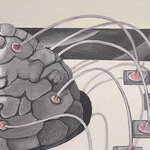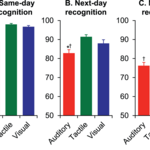Neuroscience

If you frequently experience cognitive lapses, there may be good news; psychologists say forgetting someone's name or losing your keys could be linked to the DRD2 gene.
Those who have a certain variant of this gene are more easily distracted and experience a significantly higher incidence of lapses due to a lack of attention. "Such short-term memory lapses are very common, but some people experience them particularly often," said Prof. Dr. Martin Reuter from the department for Differential and Biological Psychology at the University of Bonn in their statement.
But mistakes…

Humans are creatures of sight, then we think in terms of feel and then sound. The human sense of smell does not get the credit it deserves, according to a new paper.
In an experiment led by Andreas Keller, of Rockefeller's Laboratory of Neurogenetics and Behavior, the ability of volunteers to distinguish between complex mixtures of scents was tested. Based on the sensitivity of these people's noses and brains, the team calculated the human sense of smell can detect more than 1 trillion odor mixtures - the existing generally accepted number is just 10,000.
In fact, even 1 trillion may be…

Researchers from University College Londonand Cambridge University says have found evidence of a specialized mechanism for spatial self-awareness that combines visual cues with body motion - that our ability to instantly link what you see with what we do is thanks to a dedicated information 'highway'.
Standard visual processing is prone to distractions, as it requires us to pay attention to objects of interest and filter out others. The new study has shown that our brains have separate 'hard-wired' systems to visually track our own bodies, even if we are not paying attention to them. In…

What does creative thought look like in the brain? With the willing brains of creative people and tools like fMRI that can look inside these brains in real-time, you'd think it would an easy question to answer. The problem is, creative people don't always think creatively – when you stick a creative person in an fMRI tube and prod them to have creative thoughts, the result is a little like throwing electric spaghetti into the air: it's all over the place and nearly impossible to discover which strands in which areas of the brain are responsible for the "novel, useful thought" we commonly call…

People with bipolar disorder, as much as one percent of the population, undergo a veritable roller coaster of emotions.
They experience extreme shifts in mood, from manic phases with delusions of grandeur, increased drive and a decreased need for sleep as well as depressive episodes with a severely depressed mood to the point of suicidal thoughts.
Under the direction of scientists from Bonn, Mannheim and Basel, an international collaboration of researchers discovered two new gene regions that are connected to the prevalent disease. In addition, they were able to confirm three…

Maintaining physical health brings a variety of benefits - including for the brain. A new study affirms that but also finds that lower IQ in teen years is correlated to a higher risk of dementia before the age of 60.
IQ doesn't really go up or down much so IQ at a young age isn't telling us much, but a study of one million young Swedish men included the data so it ended up being a factor.
Researchers at the Sahlgrenska Academy of Gothenburg University previously analyzed Swedish men's conscription results and were able to show a correlation between cardiovascular fitness as a teenager and…

People born unable to see are readily capable of learning to perceive the shape of the human body through soundscapes that translate images into sound, according to a new article in Current Biology.
With a little training, soundscapes representing the outlines and silhouettes of bodies cause the brain's visual cortex—and specifically an area dedicated in normally sighted people to processing body shapes—to light up with activity.
With no more than 70 hours of training on average, study participants could recognize the presence of a human form. What's more, they were able to detect the exact…

At age 6, Mozart performed at the court of the Prince-elect
Maximilian II of Bavaria. At age 8, Joy Foster represented Jamaica in table
tennis at the Caribbean championships in Trinidad.
What do the brains of these
two child prodigies have in common?
Not as much as you might think: a
study published this week in the journal Intelligence shows that one size
brain does not fit all prodigies – the brains of math prodigies are different
than those of art prodigies are different than those of music prodigies. But
for every prodigy, there's a profile: distinct brain abilities help to make…

There is a growing need for Cognitive Rehabilitation Therapy (CRT) due to athletes with sports-related head injuries, a growing population with age-related cognitive decline and soldiers returning from war zones with brain injuries.
A special collection of articles in NeuroRehabilitation illustrates the art and science of restoring mental functioning in those who have suffered a debilitating injury or who may otherwise have problems with attention, comprehension, learning, remembering, problem solving, reasoning, and processing.
CRT has its origins in the development of therapy for…

Our brains may not be optimized for recalling things we hear, the way we are good at remembering things we see or touch.
Psychologists doing a study of over 100 University of Iowa college students found that they were less able to recall a variety of sounds the way they could visuals and things they felt.
In an experiment testing short term-memory, participants were asked to listen to pure tones they heard through headphones, look at various shades of red squares, and feel low-intensity vibrations by gripping an aluminum bar.
Each set of tones, squares and vibrations was separated by…